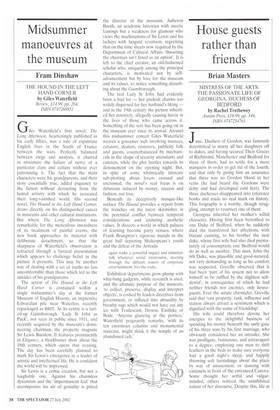Midsummer manoeuvres at the museum
Fram Dinshaw
THE HOUND IN THE LEFT HAND CORNER by Giles Waterfield Review, £14.99, pp. 284, ISBN 0747268851 G iles Waterfield's first novel, The Long Afternoon, hearteningly published in his early fifties, was a tale of expatriate English lives in the South of France between the wars. Perfectly balanced between elegy and analysis, it charted in miniature the failure of nerve of a particular class and culture without ever patronising it, The fact that the main characters were his grandparents, and their story essentially true, added piquancy to the fiction without detracting from the lustral artistry with which he recreated their long-vanished world. His second novel, The Hound in the Left Hand Corner, draws directly on his distinguished career in museums and other cultural institutions. But where The Long Afternoon was remarkable for the meticulous inwardness of its treatment of painful events, the new book approaches its material with deliberate detachment, so that the sharpness of Waterfield's observation is refracted through a farcical presentation which appears to challenge belief in the picture it presents. This may be another way of dealing with a set of truths no less uncomfortable than those which led to the suicides of his grandparents.
The action of The Hound in the Left Hand Corner is contained within a single midsummer's day at the former Museum of English History, an impressive Edwardian pile near Waterloo, recently repackaged as BRIT. At its centre is a tarted-up Gainsborough, 'Lady St John as Puck', not seen in public since 1911, and recently acquired by the museum's domineering chairman, the property magnate Sir Lewis Burstem. It features prominently in Elegance, a blockbuster show about the 18th century, which opens that evening. The day has been carefully planned to mark Sir Lewis's emergence as a leader of artistic and intellectual life. He is confident the world will be impressed.
Sir Lewis is a comic creation, but not a laughable one. Against his charmless dynamism and the 'impermanent feel' that accompanies his air of geniality is pitted the director of the museum, Auberon Booth, an academic historian with ascetic leanings but a weakness for glamour who views the machinations of Sir Lewis and his lackeys with languid revulsion, regretting that on the time sheets now required by the Department of Cultural Affairs 'thwarting the chairman isn't listed as an option'. It is left to the chief curator, an old-fashioned scholar who, uniquely among the principal characters, is motivated not by selfadvancement but by love for the museum and its values, to notice something disturbing about the Gainsborough.
The real Lady St John had evidently been a bad lot — her puckish charms too widely dispersed for her husband's liking — and in the 19th century the picture inherited her notoriety, allegedly causing havoc in the lives of those who came across it. Something of the sort has been going on in the museum ever since its arrival. Around this midsummer conceit Giles Waterfield weaves a gossamer web involving trustees, curators, dealers, restorers, publicity folk and guests, counterbalanced by mechanicals in the shape of security attendants and caterers, while the plot hurtles towards its denouement on the opening night. But, in spite of some whimsically intricate sub-plotting about lovers crossed and uncrossed, the novel's real focus is on delusions induced by money, success and fashion, not love.
Beneath its deceptively masque-like surface The Hound provides a report from the trenches on the latest skirmishes in the perennial conflict between temporal considerations and enduring aesthetic values. It dissects a world in which palaces of learning become party venues: where Frank Brangwyn's vigorous murals in the great hall depicting Shakespeare's youth and the defeat of the Armada
again make a powerful impact and stimulate talk whenever social intercourse, steering through the difficult waters of corporate entertainment, hits the rocks.
Exhibition departments grow plump with whiz-bang gadgetry, while research is axed, and the ultimate purpose of the museum, 'to collect, preserve, display and interpret objects', is coshed by leaden directives from government, or inflated into absurdity by breathy tags which would not have cut any ice with Tradescant, Denon, Eastlake or Bode. 'Anyone glancing at the portico,' Waterfield poignantly remarks, 'with its ten enormous columns and monumental staircase, might think it the temple of an abandoned cult.'
































































 Previous page
Previous page